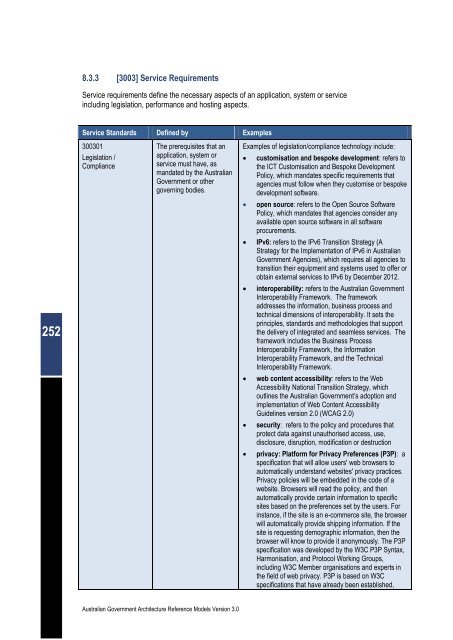Australian Government Architecture Reference Models Version 3.0
Australian Government Architecture Reference Models Version 3.0
Australian Government Architecture Reference Models Version 3.0
You also want an ePaper? Increase the reach of your titles
YUMPU automatically turns print PDFs into web optimized ePapers that Google loves.
252<br />
8.3.3 [3003] Service Requirements<br />
Service requirements define the necessary aspects of an application, system or service<br />
including legislation, performance and hosting aspects.<br />
Service Standards Defined by Examples<br />
300301<br />
Legislation /<br />
Compliance<br />
The prerequisites that an<br />
application, system or<br />
service must have, as<br />
mandated by the <strong>Australian</strong><br />
<strong>Government</strong> or other<br />
governing bodies.<br />
<strong>Australian</strong> <strong>Government</strong> <strong>Architecture</strong> <strong>Reference</strong> <strong>Models</strong> <strong>Version</strong> <strong>3.0</strong><br />
Examples of legislation/compliance technology include:<br />
� customisation and bespoke development: refers to<br />
the ICT Customisation and Bespoke Development<br />
Policy, which mandates specific requirements that<br />
agencies must follow when they customise or bespoke<br />
development software.<br />
� open source: refers to the Open Source Software<br />
Policy, which mandates that agencies consider any<br />
available open source software in all software<br />
procurements.<br />
� IPv6: refers to the IPv6 Transition Strategy (A<br />
Strategy for the Implementation of IPv6 in <strong>Australian</strong><br />
<strong>Government</strong> Agencies), which requires all agencies to<br />
transition their equipment and systems used to offer or<br />
obtain external services to IPv6 by December 2012.<br />
� interoperability: refers to the <strong>Australian</strong> <strong>Government</strong><br />
Interoperability Framework. The framework<br />
addresses the information, business process and<br />
technical dimensions of interoperability. It sets the<br />
principles, standards and methodologies that support<br />
the delivery of integrated and seamless services. The<br />
framework includes the Business Process<br />
Interoperability Framework, the Information<br />
Interoperability Framework, and the Technical<br />
Interoperability Framework.<br />
� web content accessibility: refers to the Web<br />
Accessibility National Transition Strategy, which<br />
outlines the <strong>Australian</strong> <strong>Government</strong>’s adoption and<br />
implementation of Web Content Accessibility<br />
Guidelines version 2.0 (WCAG 2.0)<br />
� security: refers to the policy and procedures that<br />
protect data against unauthorised access, use,<br />
disclosure, disruption, modification or destruction<br />
� privacy: Platform for Privacy Preferences (P3P): a<br />
specification that will allow users' web browsers to<br />
automatically understand websites' privacy practices.<br />
Privacy policies will be embedded in the code of a<br />
website. Browsers will read the policy, and then<br />
automatically provide certain information to specific<br />
sites based on the preferences set by the users. For<br />
instance, if the site is an e-commerce site, the browser<br />
will automatically provide shipping information. If the<br />
site is requesting demographic information, then the<br />
browser will know to provide it anonymously. The P3P<br />
specification was developed by the W3C P3P Syntax,<br />
Harmonisation, and Protocol Working Groups,<br />
including W3C Member organisations and experts in<br />
the field of web privacy. P3P is based on W3C<br />
specifications that have already been established,

















